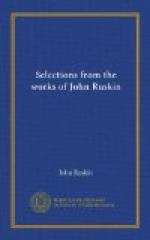[Sidenote: Art dependent upon personal and national greatness.]
Amidst the maze of subjects, then, which Ruskin, with kaleidoscopic suddenness and variety, brings before the astonished gaze of his readers, let them confidently hold this guiding clue. They will find that Ruskin’s “facts” are often not facts at all; they will discover that many of Ruskin’s choicest theories have been dismissed to the limbo of exploded hypotheses; but they will seek long before they find a more eloquent and convincing plea for the proposition that all great art reposes upon a foundation of personal and national greatness. Critics of Ruskin will show you that he began Modern Painters while he was yet ignorant of the classic Italians; that he wrote The Stones of Venice without realizing the full indebtedness of the Venetian to the Byzantine architecture; that he proposed to unify the various religious sects although he had no knowledge of theology; that he attempted a reconstruction of society though he had had no scientific training in political economy; but in all this neglect of mere fact the sympathetic reader will discover that contempt for the letter of the law which was characteristic of the nineteenth-century prophet,—of Carlyle, of Arnold, and of Emerson,—and which, if it be blindness, is that produced by an excess of light.
[5] See Harrison’s Life,
p. 111. Cf. the opening of The Mystery
of Life.
[6] Part 2, sec. 1, chap. 4.
[7] See p. 159.
[8] Modern Painters, vol. 1, part 2, sec. 1, chap. 7.
[9] Unto This Last.
[10] See p. 262.
III
RUSKIN’S STYLE
[Sidenote: Sensuousness of his style.]
Many people regard the style of Ruskin as his chief claim to greatness. If the time ever come when men no longer study him for sermons in stones, they will nevertheless turn to his pages to enjoy one of the most gorgeous prose styles of the nineteenth century. For a parallel to the sensuous beauties of Ruskin’s essays on art, one turns instinctively to poetry; and of all the poets Ruskin is perhaps likest Keats. His sentences, like the poet’s, are thick-set with jeweled phrases; they are full of subtle harmonies that respond, like a Stradivarius, to the player’s every mood. In its ornateness Ruskin’s style is like his favorite cathedral of Amiens, in the large stately, in detail exquisite, profuse, and not without a touch of the grotesque. It is the style of an artist.
[Sidenote: Ruskin’s method of construction in description.]




